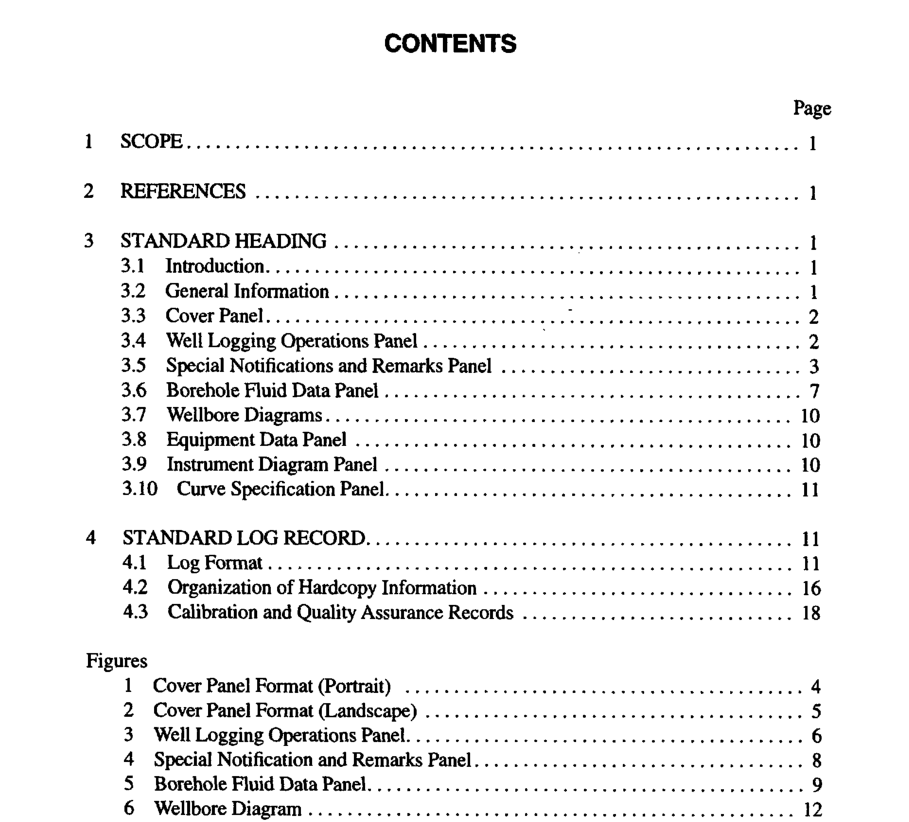API RP 31A pdf download

API RP 31A pdf download.Standard Form for Hardcopy Presentation of Downhole Well Log Data
1 Scope
The variety, use, and value of log recordings of subsurface properties have been greatly increased and expanded since last revision of Recommended Practice 31. A wide diver- sity oflog measurements (from and cased routinely being combined to interpret the original status of newly drilled wells and to evaluate performance and potential throughout each well’s life. Standardization of the log form and data presentation will allow the user to conveniently com- bine log data from various devices and dates. Recognizing the wide variability in covered by these recommenda- tions, this document attempts to flexibility wherever format selected allows for presentation of data can be measured as a series of values at specified well depths. Consequently, this document can be easily applied to most logging measurements, and will as a reference document to technology-specific document makes no recommendations concerning the standard log record (refer to Section 4) for measurements that are data series at individual depths (for pressure transients, video images, sonic traces, and so forth). To the extent that recommended practices for the presentation of such data are appropriate, they should be included within om- mended Practices for the technologies involved. In addition to the recommendations concerning the format for presentation of log document provides several enhancements to the standard log heading. These changes are designed to provide the user with a more complete set of information in consistent locations on all logs. Due to the increasing use of tool calibration and data processing while logging, recommendations are provided concerning docu- mentation of equipment history and processing software. One should identify tool-specific information in other appropriate recommended publications.The recommended additions to the content of the support information included with hardcopy presentations of well log data, as described in the following, should also be included with digital recordings of the same well logs. The recom- mended digital formats to be used are provided in API Rec- ommended Practice 66. The recommendations contained within API Recom- mended Practice 31A provide some flexibility regarding the dimensions of the actual print field used in the hardcopy pre- sentation of well log data. This fiexibility will accommodate the use of commonly available printers and paper sizes as optional alternatives to the 6.25-inch by 9.25-inch fanfold paper on which log data has been traditionally printed. Exam- ple figures conforming to this document and printed at the dimensions required for 8.5-inch by 11-inch paper are pro- vided. The changes made to accommodate this flexibility in paper and printer selection will in no way alter the actual scal ” ing of the log data. Log data curves will precisely “ overlay ,’’ of the choice of paper or print field dimensions. Any hardcopy presentation of log data that meets all of the information content and format specifications described in the text of this document shall be considered to be in con- formance with it.
3 Standard Heading
3.1 INTRODUCTION A recommended standard heading has been developed for all downhole well log data, which provides space for infor- mation pertinent to the interpretation of these logs. This infor- mation should be recorded on feld copies as well as on final prints because considerable log interpretation is made from field copies. The logging company is normally responsible for recording complete standard-heading data. However, the logging company depends upon the operator for much of these data. Thus the operator shares the responsibility for pro- viding complete and accurate data. 3.2 GENERAL INFORMATION The recommended standard log heading has four parts consisting of a cover panel, followed consecutively by panels for well logging operations, borehole fuid properties, and a wellbore diagram. Generally, the length of each panel is between 8 inches and 8.25 inches, and the width is between 5.5 inches and 6 inches. Acceptable alternative formats are identified for specific panels in the detailed descriptions pro- vided in the following.









